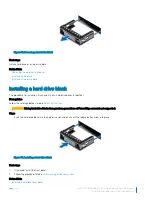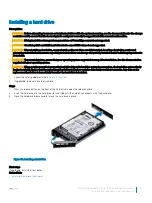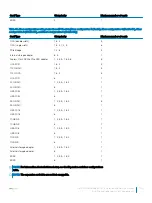
Configuration
Description
Memory population rules
Configuration 14
12x 32 GB RDIMMs, 12x NVDIMM-Ns
RDIMMs – Same for all 12x RDIMM
configurations. See Config 1
NVDIMM-N – C1{7,8,9,10,11,12},
C2{7,8,9,10,11,12}
Mode-specific guidelines
Six memory channels are allocated to each processor. The configurations allowed depend on the memory mode selected.
Memory optimized (independent channel) mode
This mode supports Single Device Data Correction (SDDC) only for memory modules that use x4 device width. It does not impose any
specific slot population requirements.
Memory sparing
NOTE:
To use memory sparing, this feature must be enabled in BIOS menu of System Setup.
Table 40. Memory sparing
Memory sparing (Single Rank)
Memory sparing allocates one rank per channel as a spare. If
excessive correctable errors occur in a rank or channel, they are
moved to the spare area while the operating system is running to
prevent errors from causing an uncorrectable failure. Requires
population of two ranks or more per channel.
Memory sparing (Multi Rank)
Memory sparing allocates two ranks per channel as a spare. If
excessive correctable errors occur in a rank or channel, they are
moved to the spare area while the operating system is running to
prevent errors from causing an uncorrectable failure. Requires
population of three ranks or more per channel.
With single rank memory sparing enabled, the system memory available to the operating system is reduced by one rank per channel. For
example, in a dual-processor configuration with twenty four 16 GB dual-rank memory modules, the available system memory is: 3/4 (ranks/
channel) × 24 (memory modules) × 16 GB = 288 GB, and not 24 (memory modules) × 16 GB = 384 GB. This calculation changes based on
if it is single rank sparing or multi rank sparing. For multi rank sparing, the multiplier changes to 1/2 (ranks/channel).
NOTE:
Memory sparing does not offer protection against a multi-bit uncorrectable error.
Memory mirroring
Memory mirroring offers the strongest memory module reliability mode, providing improved uncorrectable multi-bit failure protection. In a
mirrored configuration, the total available system memory is one half of the total installed physical memory. Half of the installed memory is
used to mirror the active memory modules. In the event of an uncorrectable error, the system switches over to the mirrored copy. This
ensures Single Device Data Correction (SDDC) and multi-bit protection.
The installation guidelines for memory modules are as follows:
•
Memory modules must be identical in size, speed, and technology.
•
Memory modules must be populated in sets of 6 per CPU to enable memory mirroring.
Dell EMC PowerEdge R740 Installation and Service Manual
Installing and removing system components
93






























